
Monks watch the Lamaist devil dance ceremony at Tsurpu Monastery, about 70 kilometers of Lhasa, capital of southwest China's Tibet Autonomous Region, Feb. 23, 2009. A ceremonial dance performed by the Lamaists was held here at Tsurpu Monastery on Feb. 23, on the equivalent of Dec. 29 of the Tibetan calendar. The Lamaist devil dance, so called "cham" in Tibetan language, is believed to ward off disasters and ghosts and bring luck and happiness, as Lamas in traditional costumes perform solo dance, duet dance or collective dance, photo from Xinhua.
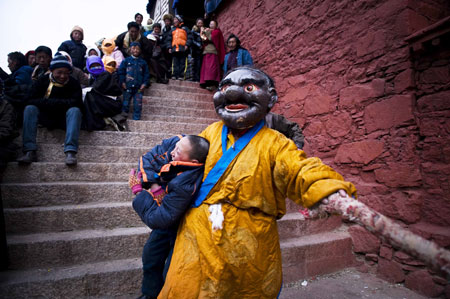
A monk plays with a child during the Lamaist devil dance ceremony at Tsurpu Monastery, about 70 kilometers of Lhasa, capital of southwest China's Tibet Autonomous Region, Feb. 23, 2009, photo from Xinhua.
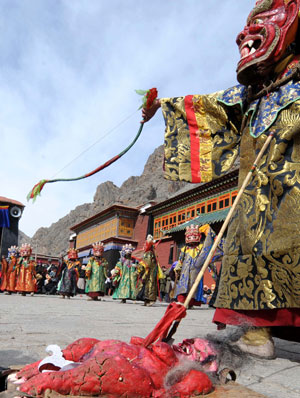
A monk "kills" devil during the Lamaist devil dance ceremony at Tsurpu Monastery, about 70 kilometers of Lhasa, capital of southwest China's Tibet Autonomous Region, Feb. 23, 2009, photo from Xinhua.

Monks in masks perform during the Lamaist devil dance ceremony at Tsurpu Monastery, about 70 kilometers of Lhasa, capital of southwest China's Tibet Autonomous Region, Feb. 23, 2009, photo from Xinhua.

Monks in masks perform during the Lamaist devil dance ceremony at Tsurpu Monastery, about 70 kilometers of Lhasa, capital of southwest China's Tibet Autonomous Region, Feb. 23, 2009, photo from Xinhua.
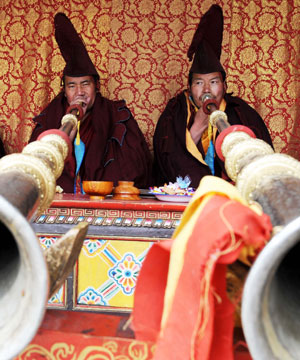
Monks blow bugles during the Lamaist devil dance ceremony at Tsurpu Monastery, about 70 kilometers of Lhasa, capital of southwest China's Tibet Autonomous Region, Feb. 23, 2009, photo from Xinhua.
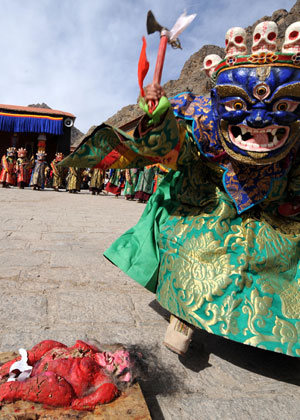
A monk "kills" devil during the Lamaist devil dance ceremony at Tsurpu Monastery, about 70 kilometers of Lhasa, capital of southwest China's Tibet Autonomous Region, Feb. 23, 2009, photo from Xinhua.

A monk strikes a drum during the Lamaist devil dance ceremony at Tsurpu Monastery, about 70 kilometers of Lhasa, capital of southwest China's Tibet Autonomous Region, Feb. 23, 2009, photo from Xinhua.
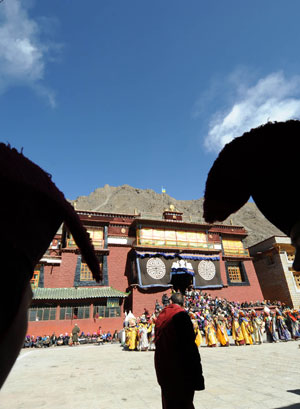
Monks in masks perform during the Lamaist devil dance ceremony at Tsurpu Monastery, about 70 kilometers of Lhasa, capital of southwest China's Tibet Autonomous Region, Feb. 23, 2009, photo from Xinhua.
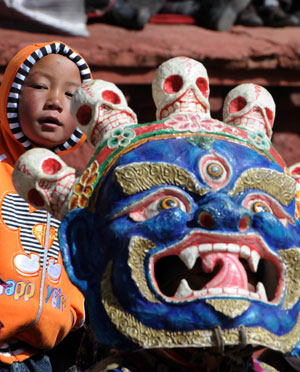
A monk in mask performs during the Lamaist devil dance ceremony at Tsurpu Monastery, about 70 kilometers of Lhasa, capital of southwest China's Tibet Autonomous Region, Feb. 23, 2009, photo from Xinhua.
